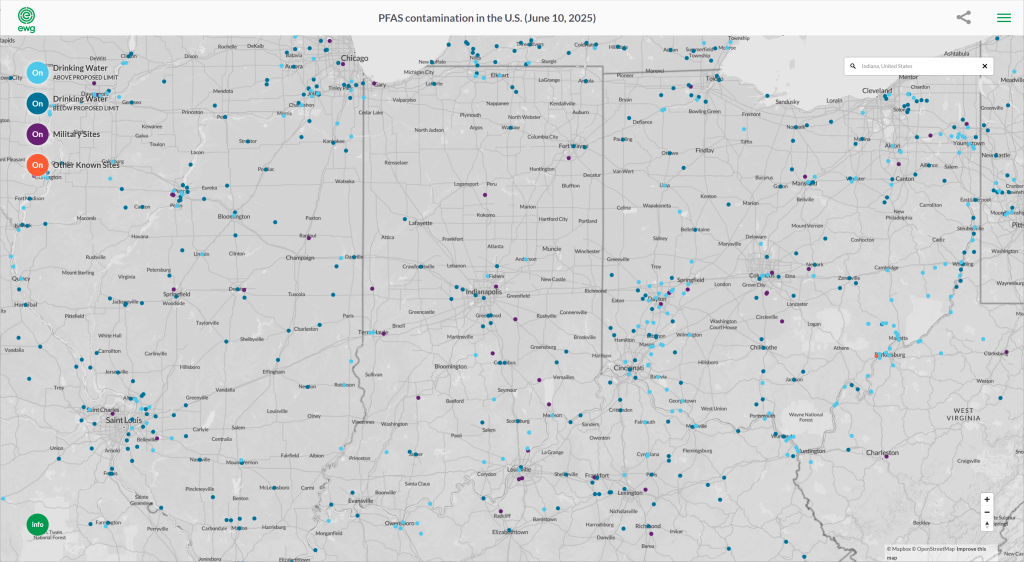- Home
- Personal Injury
- PFAS Lawsuit
- PFAS Contamination Map
- PFAS in Indiana
PFAS in Indiana
- Last updated: July 16, 2025
-
Contributor: nicky

I have spent considerable time reading about PFAS in Indiana, and the scope of contamination here is more extensive than many people realize. Per- and polyfluoroalkyl substances (PFAS), sometimes called “forever chemicals,” can remain in the environment for decades without breaking down. In my view, the danger stems from the way PFAS build up in water supplies, soil, and even our bodies. People here in Indiana are increasingly concerned about their drinking water, crops, livestock, and long-term health.
PFAS contamination in Indiana has led to multiple responses at both the state and federal levels. In this article, I will walk through what PFAS are, how they affect our local environment, and why public-health experts stress caution about continued exposure. Although the effects can vary from kidney cancer to thyroid disease, there are ways we can respond. From monitoring programs led by the Indiana Department of Environmental Management (IDEM) to newly published federal regulations, organizations are starting to address potential harm.
What are PFAS and why are they dangerous?
PFAS refers to a large group of man-made chemicals that have been used since the 1940s in a wide range of consumer and industrial applications. This includes firefighting foams, nonstick cookware, water-resistant clothing, and grease-resistant food packaging.
I find it concerning that these chemicals are so stable they do not break down easily. As a result, PFAS can persist in soil, surface water, wildlife, and the human body for years. Research shows that long-term exposure to specific PFAS compounds may increase the risk of kidney cancer, liver damage, testicular cancer, and other illnesses.
The Environmental Protection Agency (EPA) has reported that certain PFAS, such as PFOA and PFOS, are toxic at low levels. Because these chemicals do not degrade, they can accumulate along the food chain, posing a persistent threat to public health. According to scientists at the Environmental Working Group, over 600 species may be at risk of harm from PFAS contamination in water and other ecosystems.
Where are PFAS found in Indiana?
I have learned that PFAS contamination in Indiana has been detected in varying concentrations across multiple sites. Some communities face elevated PFAS levels in their municipal water supplies, while others see smaller traces in private wells or local rivers. According to IDEM, PFAS have already been sampled at all Community Public Water Systems (CWS) in Indiana since early 2021.
Additionally, areas near military installations, such as Grissom Air Reserve Base and Camp Atterbury, have drawn scrutiny. These installations historically used firefighting foams containing PFAS. Today, efforts are ongoing to track how far contamination may have spread from training or firefighting sites. IDEM has also expanded its plan to test PFAS occurrence in certain non-transient non-community systems, which usually serve schools and daycares.
PFAS in Indiana’s drinking water
When I look at Indiana’s PFAS challenges, the most critical focal point is the drinking water supply. The chemicals can pass through conventional treatment plants and end up in tap water unless specialized filtration is in place. In April 2024, the U.S. EPA finalized a National Primary Drinking Water Regulation establishing Maximum Contaminant Levels (MCLs) for six PFAS. These federal standards took full effect on June 25, 2024, aiming to protect public health by requiring stricter limits in finished drinking water.
Affected cities and water systems
According to IDEM’s statewide testing results, smaller communities under 10,000 residents were sampled first because they had not been included in earlier federal monitoring. While some water systems showed no verified PFAS detections, others had measurable concentrations of these chemicals in raw or finished water.
IDEM indicated that Jeffersonville became a focal point for PFAS concerns after a lawsuit was filed on November 20, 2024, alleging life-altering health complications due to exposure. In that case, the suit seeks “compensation for the harm caused by these forever chemicals.” Public interest in further testing grew after these legal developments, prompting some cities to consider additional water-treatment protocols to lower PFAS concentrations.
Statewide monitoring programs
Since February 2021, IDEM has facilitated PFAS sampling at raw and finished water points in all Indiana community systems. Officials said, “No verified PFAS detections were found in Indiana during the UCMR sampling event,” referencing the EPA’s Unregulated Contaminant Monitoring Rule operation completed in 2015. However, as new funding became available, IDEM extended its Emerging Contaminants Grant to study surface-water sources and track potential PFAS distribution beyond major population centers.
Key goals of these programs include:
- Identifying systems with elevated PFAS levels
- Sharing data with water utility managers so they can implement effective filtration
- Tracking trends in areas with historic or nearby industrial activity
- Military-linked contamination sites
Military bases are notable PFAS sources because of firefighting foam used in drills and emergencies. In Indiana, bases like Grissom Air Reserve Base and Camp Atterbury have undergone official reviews to determine how much foam was used and whether local groundwater was affected. Where data suggests potential contamination, specialized cleanup strategies might be pursued under state-federal collaboration.
PFAS in Indiana’s soil and agriculture
PFAS can seep into the ground and impact farms or backyard gardens. I have spoken with residents who worry about how PFAS might affect the safety of produce or livestock raised in tainted soil or irrigated with contaminated water. While the state has not fully mapped agricultural PFAS levels, the same chemicals found in water can accumulate in the soil and potentially move into crops.
Agricultural areas near industrial plants, landfills, or wastewater treatment facilities may face greater exposure. Additionally, PFAS-laden biosolids used as fertilizer can pose a risk if they contain residual chemicals. Although more research is needed to determine the full extent of PFAS in Indiana’s soil, some farmers are already re-examining their fertilizer sources and water-testing protocols.
Health effects of PFAS exposure
Scientists continue to explore PFAS exposure, but consensus indicates these chemicals can lead to chronic health problems. I often see kidney cancer and testicular cancer mentioned as two major concerns. Other issues include:
- Thyroid disease
- Elevated cholesterol levels
- Changes in liver enzymes and function
- Autoimmune disorders or weakened immunity
Children, in particular, may be more sensitive to PFAS effects. According to the Centers for Disease Control (CDC), infants could be exposed through breast milk or formula made with PFAS-contaminated water. Prolonged exposure might also increase the likelihood of developmental issues.
PFAS-linked diseases in Indiana
Indiana residents who have been exposed to PFAS over many years have also reported higher rates of certain diseases. While causation is still being studied, multiple health alerts have drawn a connection between PFAS and several conditions. The CDC released a health alert on January 26, 2024, reinforcing that PFAS exposure correlates with heightened risk for kidney cancer.
Kidney cancer
Among the most closely examined PFAS-related risks is kidney cancer, particularly renal cell carcinoma. Studies show that PFOA, one of the widely recognized PFAS compounds, may significantly increase the likelihood of this disease. Anyone who has lived near a well-documented PFAS source for an extended period should consider regular screenings for early detection.
Testicular cancer
Emerging research suggests that testicular cancer risk may spike in locations with high PFAS levels. Military bases and nearby communities, which historically used large amounts of Aqueous Film Forming Foam (AFFF), appear especially affected.
Thyroid disease
Chronic thyroid disease can manifest through symptoms including fatigue, weight changes, or temperature sensitivity. In my own discussions with local residents, many are concerned that subclinical PFAS effects on the thyroid may be under-diagnosed.
Liver damage and cholesterol changes
Liver toxicity studies have indicated that PFAS may affect liver enzymes, leading to increased cholesterol levels and, in some cases, potential liver damage over time. While the extent of harm can vary widely among individuals, patients with an existing history of liver or lipid issues may want to consult their healthcare provider about PFAS exposure risks.
How Indiana is responding to the PFAS crisis
Indiana’s approach to PFAS contamination is multifaceted. IDEM has expanded its monitoring framework. Meanwhile, the EPA’s updated rules are pushing both state officials and local water utilities to adapt quickly. In my view, this concerted effort underscores a broader recognition that PFAS are not just an environmental nuisance, but a public health concern requiring proactive management.
Indiana Department of Environmental Management (IDEM) efforts
IDEM formally launched a large-scale PFAS screening in February 2021 for all Community Public Water Systems across the state. Smaller systems were sampled first, followed by larger ones, to fill data gaps from the prior federal study. In its official summary, IDEM noted that “No verified PFAS detections were found in Indiana during the UCMR sampling event,” but new tests suggest that limited exposures do exist in certain regions.
In 2024, the program extended to surface-water bodies used for drinking water. A next phase will include sampling at non-transient non-community sites, primarily schools and daycare facilities, so that children’s exposure risks can be better assessed. IDEM has also been analyzing fish tissue for PFAS since 2017 to track bioaccumulation patterns in Indiana’s rivers, lakes, and reservoirs.
PFAS sampling of public water systems
While testing helps determine which water systems are at risk, it also highlights the efficacy of conventional drinking water treatment in removing PFAS. In some cases, systems might find that carbon filtration or reverse-osmosis processes can dramatically reduce PFAS concentrations. IDEM recommends frequent re-testing for utilities that initially tested positive, ensuring consistent quality over time.
Federal and state cleanup collaborations
At the federal level, the U.S. EPA continues to develop regulations and guidance for PFAS-laden sites. Newly established MCLs require water systems to limit PFAS levels to near-zero for compounds like PFOA and PFOS. States, including Indiana, often coordinate with federally managed cleanup programs for legacy contamination at military bases or industrial complexes.
In these cooperative efforts, responsible parties could include manufacturers of firefighting foam, large chemical firms, or local entities that utilized PFAS-heavy materials. By sharing data and standardizing approaches, the EPA and state agencies can more effectively target environmental restoration and public health safeguards.
Can you test your water or soil for PFAS in Indiana?
I am frequently asked what steps private residents can take to identify possible PFAS exposure in their homes. If you use a private well, you can hire a certified environmental laboratory to conduct PFAS-specific testing. Certain labs employ EPA-approved methods like Method 1633 for aqueous samples.
For soil testing, specialized protocols for PFAS exist, although they are more complex than standard pesticide analyses. If you suspect contamination near your property, especially from industrial runoff or firefighting foam usage, you may want to coordinate with IDEM or an accredited environmental consultant to ensure accurate results.
Do you qualify for a PFAS lawsuit in Indiana?
Individuals living in areas with well-documented PFAS contamination may be eligible to file a lawsuit, particularly if they have suffered health effects linked to these chemicals. On November 20, 2024, a Jeffersonville resident initiated legal action after alleging PFAS exposure led to severe complications. These cases often focus on:
- Demonstrating that pollutants exceeded safe thresholds
- Highlighting corporate or institutional negligence tied to PFAS release
- Linking chronic exposure to a medically verified health diagnosis
If you suspect your illness or that of a loved one stems from PFAS, you might want to consult an attorney who handles large environmental and toxic tort claims. In certain instances, class-action or mass-tort litigation may be appropriate, especially if multiple people in your area share similar diagnoses.
I encourage you to review additional details on filing a water contamination lawsuit. You can also learn more about suits targeting major chemical producers, including the DuPont lawsuit overview.
Why choose Legal Claim Assistant
As I see it, navigating PFAS claims can be daunting. Legal Claim Assistant helps simplify the process by connecting you with an experienced legal team. Their network offers free case reviews to potential plaintiffs, and attorneys can evaluate whether your exposure, medical conditions, or location supports filing a PFAS-related claim.
To learn more about legal options, visit the Legal Claim Assistant PFAS Lawsuit page. Their site provides clear steps for gathering medical documentation, water-testing results, and expert opinions. By organizing these details, you gain a stronger foundation upon which to pursue compensation.
Frequently asked questions (FAQ)
In speaking with community members, I have noticed recurring questions about PFAS sources, regulations, and the possibility of filing lawsuits. Below are some of the most common ones, along with my understanding from state and federal updates.
Contamination appears concentrated in areas with industrial histories, firefighting training facilities, or large landfill sites. According to IEPA data, some of the most significant detections took place in Lincoln and other locations where levels exceeded 4 ppt for PFOA and PFOS. However, PFAS can show up in both urban and rural communities, so ongoing testing remains crucial.
Yes. You can hire certified private labs or get in touch with the IDPH for assistance. Community water results are published on IEPA platforms, but private wells need separate sampling. I suggest contacting a laboratory that specializes in PFAS testing and using NSF-certified filtration systems to reduce risk.
The state adopted new groundwater quality standards for six PFAS, mandating that community water systems act if they exceed these limits. Water supply owners and operators must notify residents within five business days upon receiving an official exceedance notice. The IEPA also issues advisories and enforces guidelines for the removal or reduction of PFAS in municipal water systems.
While contamination primarily makes headlines in public water, PFAS can migrate into soil and crops through irrigation. Findings on agricultural contamination are still evolving, but there is evidence from other states showing PFAS uptake in produce and livestock. Farmers relying on contaminated wells might need to explore filtration or alternative water sources to limit possible PFAS absorption by plants or animals.
Leading concerns include elevated cholesterol, potential immune system impacts, and reproductive or developmental harm. Studies also point to higher risks of kidney and testicular cancers, as well as thyroid diseases, particularly for PFOA and PFOS. Any individual who suspects PFAS exposure might consult a physician for screening and professional medical advice.
Potentially, yes. PFAS lawsuits often target chemical manufacturers or businesses responsible for contamination. If tests confirm high PFAS levels in your water or soil, and if you have suffered health or property-related damage, you could be entitled to compensation. You can request a free case review at Legal Claim Assistant to discover your options.
Overview PFAS contamination in the USA
Here you van find the PFAS watercontamination map of the United States. Find, state by state, where water contamination has occurred due to PFAS exposure.
- PFAS in Alabama
- PFAS in Alaska
- PFAS in Arizona
- PFAS in Arkansas
- PFAS in California
- PFAS in Colorado
- PFAS in Connecticut
- PFAS in Delaware
- PFAS in Florida
- PFAS in Georgia
- PFAS in Hawaii
- PFAS in Idaho
- PFAS in Illinois
- PFAS in Indiana
- PFAS in Iowa
- PFAS in Kansas
- PFAS in Kentucky
- PFAS in Louisiana
- PFAS in Maine
- PFAS in Maryland
- PFAS in Massachusetts
- PFAS in Michigan
- PFAS in Minnesota
- PFAS in Mississippi
- PFAS in Missouri
- PFAS in Montana
- PFAS in Nebraska
- PFAS in Nevada
- PFAS in New Hampshire
- PFAS in New Jersey
- PFAS in New Mexico
- PFAS in New York
- PFAS in North Carolina
- PFAS in North Dakota
- PFAS in Ohio
- PFAS in Oklahoma
- PFAS in Oregon
- PFAS in Pennsylvania
- PFAS in Rhode Island
- PFAS in South Carolina
- PFAS in South Dakota
- PFAS in Tennessee
- PFAS in Texas
- PFAS in Utah
- PFAS in Vermont
- PFAS in Virginia
- PFAS in Washington
- PFAS in West Virginia
- PFAS in Wisconsin
- PFAS in Wyoming
Related Article

What Philips CPAP Machines Are Recalled and Why

